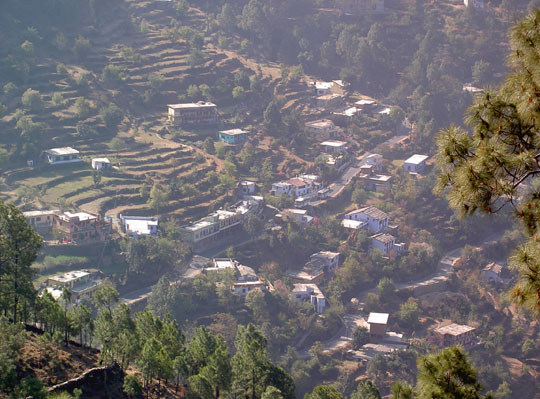
We left Nainital about 9:30 and drove north 67 kilometers (two and a half hours) to a small city called Almora, literally perched on the side of very steep mountains. When we say we “drove”, we actually mean “we were driven”; we have a driver who fortunately is from these mountains and so is pretty good at negotiating all of the blind hairpin turns. You see a bit of the town, and a couple of stretches of the road in this photo, taken from a lookout point above our hotel.
The driver, Makesh Joshie, has been told the names of the hotels to take us to, but has not been provided with any directions about where these places are, and neither have we. This also happened to us when we were down in Kerala in January, and other people tell us it is just the way things are done. For people like us who live by maps, this is very frustrating. We do actually have a pretty good road map this time, and the roads we were on had boulders every kilometer, painted with the route number (NH 87e for National Highway 87 Extension) and the km number. The trouble is the route numbers are not on the map, and the km numbers don’t say where it is 29 to or from.
Then when you get into any town or village or where there is a fork in the road, signs disappear altogether. The procedure then seems to be to start asking any random person for directions. There are some problems with this approach, however. Often asking for directions involves stopping right in the middle of traffic; once we even stopped in the center of a round-about and asked the policeman who was directing traffic. Amazingly, 99% of the time, people do also stop and give directions, whether they are walking along the road or are on a scooter or in a car headed in the opposite direction from us. Even that policeman gave us directions despite the fact that we had created grid-lock among the streams of cars, trucks, scooters and bicycles. Although 99% of people give directions, only about 50% actually know the way. Whether it is a desire to be helpful, or a reluctance to say they don’t know, they always give some sort of direction. Although we don’t catch all the words, we can sometimes see that people say “no” when the driver first asks if they know where something is; then he asks again and they give directions to it. Sometimes they even volunteer to come with us to show us the way. Not a good plan, because that still doesn’t mean that they really know. Today’s drive was pretty mild; only one wrong turn and we didn’t go too far before asking Makesh to stop and telephone the hotel, which he did and that got us back onto the correct road. Amazingly, the cell phone works even here (seven years ago there weren’t any), but we still had to stop and ask along the way to verify at each turn.
As frustrating as this method is, I don’t think there would be any other way to go about it. The roads are so twisty and the intersections so narrow, crowded and unmarked, that you could never describe the route in enough detail to get someone accurately to their destination. Really need a driver who speaks the local language and who is willing to ask for directions.


